Sean McBride's Blog, page 7
October 6, 2022
Blind Read Through: J.R.R. Tolkien; The Silmarillion, Akallabêth, part 1
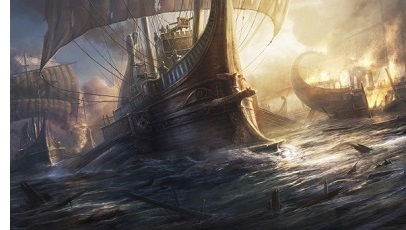
“And the Doom of Men, that they should depart, was at first a gift of Ilùvatar. It became a grief to them only because coming under the shadow of Morgoth it seemed to them that they were surrounded by a great darkness, of which they were afraid; and some grew wilful and proud and would not yield , until life was reft from them. We who beat the ever mounting burden of the years do not clearly understand this; but if that grief has returned to trouble you, as you say, then we fear that the Shadow arises once more and grows again in your hearts.“
Welcome back to another Blind Read! This week we delve into the Decendents of Elves and Men, otherwise known as the Númenorians or Dúnedain.
Tolkien begins the chapter by giving us an abridgment of the story of Men in The Silmarillion, but with a slight adjustment: “It is said by the Eldar that Men came into the world in the time of the Shadow of Morgoth, and they fell swiftly under his dominion; for he sent his emissaries among them, and they listened to his evil and cunning words, and they worshipped the Darkness and yet feared it.“
Interestingly, he begins this chapter from the perspective of the Eldar because the majority of the end of The Silmarillion has to do with how the “men” (meaning humans) helped with the ultimate defeat of Morgoth. Indeed without their influence, Morgoth would probably have taken over the land of Middle-earth.
What I find so fascinating about this passage is that Tolkien is saying that the majority of Men in the first age fell under Morgoth’s deception. However, just a select few, the Edain, who made their way West into Beleriand, were free of The Dark Lord’s corruption. Indeed, these Edain are whom we’ve read about thus far in the Quenta Silmarillion.
With Morgoth’s defeat, his thralls went back into the east, and the Edain faithful to the Valar were rewarded for their servitude. “Eönwë came among them and taught them; and they were given wisdom and power and life more enduring than any others of mortal race have possessed.”
They were also given land that was “neither part of Middle-earth nor of Valinor, for it was sundered from either by a wide sea.” The Valar raised the ground from the sea and enriched it with life, and the Star of Eärendil shone like a northern light to show the Edain how to reach that land. The land was called Andor, or “Númenóre in the High Eldarin tongue.“

“This was the beginning of that people that in the Grey-elven speech are called the Dúnedain: the Númenóreans, Kings among Men.“
These “Kings among Men” were blessed with abnormally long lives to allow them to gain wisdom and help with the progression of Men in Arda, but the original gift of Ilùvatar was still intact. The gift of death.
Ilùvatar (you can read this as God) wanted Men of Middle-earth to have the ability to die, so he gave them short lifespans. The Valar are eternal, and the Eldar are immortal unless mortally injured. So men were given short lives to appreciate the splendor that Ilùvatar and the Valar had wrought. The drawback was that none of the great human kingdoms of the First Age could produce the marvels that the Elves or even Dwarves were able to create. Thus Númenor allowed them to grow “wise and glorious, and in all things more like the Firstborn than any other of the kindreds of Men; and they were tall, taller than the tallest sons of Middle-earth; and the light of their eyes was like the bright stars.“
It was here on Númenor, the island kingdom, that Elros, brother to Elrond and son of Eärendil and Elwing, became the first King of the Dúnedain in the great city of Armenelos.

Because of his parent’s sacrifice and their mixed blood, the Valar gave the brothers the choice of whom they would live their lives. Elrond chose Noldor blood and lived the rest of his life amongst the Elves. Elros, however, decided the blood of Man, and it’s from his shared blood that the Númenórian line descended.
Elros ruled in splendor for over four hundred years, growing Númenor into the legend it would become. “The Dúnedain dwelt under the protection of the Valar and in the friendship of the Eldar, and they increased in stature both of mind and body.”
They accepted a ban from the Valar that they were not to sail to the west and thus spent their time growing in knowledge and the arts. They became great shipbuilders, as you would expect of people living on an island. They accepted gifts from the Valar and planted seedlings of the great trees of Valinor, echoing Telperion. I have to wonder if this is the antecedent of the great white tree of Gondor we see in The Lord of the Rings. The men of Gondor were, in essence, descendants of the Dúnedain, so having the tree be the standard on their armor and flags makes sense, especially because Aragorn was a descendant of those great kings.
 White Tree of Gondor. Tolkien saga. Isolated black and white eps. Lord of ring and Hobbits illustration.
White Tree of Gondor. Tolkien saga. Isolated black and white eps. Lord of ring and Hobbits illustration.It was during this time that Middle-earth’s wisdom faded, all while the Númenórian knowledge increased. It was only a matter of time before the Dúnedain would make their way to the mainland. Over the years of building ships and gaining their knowledge, a natural curiosity about the surrounding world cropped up among the Dúnedain. They were denied the ability to sail west, so naturally, they sailed east to Middle-earth’s dark lands.
This was the beginning of the corruption of the Dúnedain. They came as seekers of knowledge but went to the land that had regressed. They came to a land of people who had become hunter-gatherers and lived tribally. They came as wanderers and became conquerors. They became, in their own eyes, Gods of Middle-earth.
Join me next week as we review the second episode of The Rings of Power before returning to the saga of the Dúnedain!
September 29, 2022
Updates 09/29/22
Hey everyone! I needed to take a week off from the blog because my work obligations were too heavy this week, so I figured I’d give an update on everything coming in the next six months! I’ve been working hard on other projects besides the Blind Read Blog, and the spoils of that work will soon pay off! Let’s get to it then.
Blind Read Series:
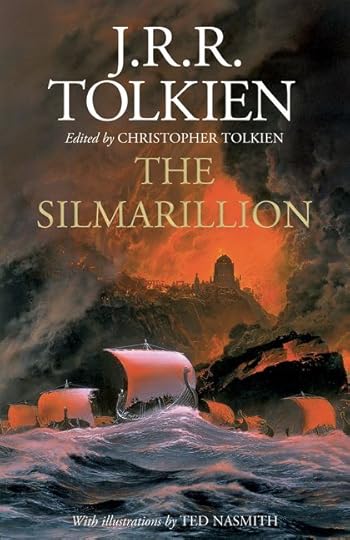
There are probably about five more weeks left in The Silmarillion, but I also plan on doing an episode by episode “Blind Watch” analysis with Amazon Prime “The Rings of Power” as well as analyzing the original movies and contrasting them with the information from the earlier ages of Middle-earth. Once The SIlmarillion is completed, I’ll move onto “The Book of Lost Tales, Part 1.” The formatting for these Blogs will be slightly different however, because this books seems to be more of a early/poetic version of The Simlarillion.
Short Stories:
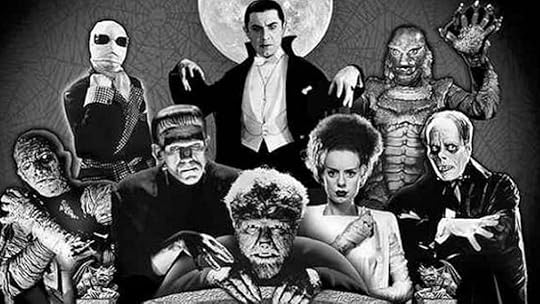
I’m bringing back the Universal Monster horror shorts, which will be published every Saturday, from Ocotber 1st through the end of the year. I’ll have some surprise new stories (there are only 7 published shorts previously) mixed in there as well for the next 14 weeks! These stories are all pretty short (between 1k and 3k words) so they’re a quick and fun introduction to Autumn!
Elsie Jones Adventures:
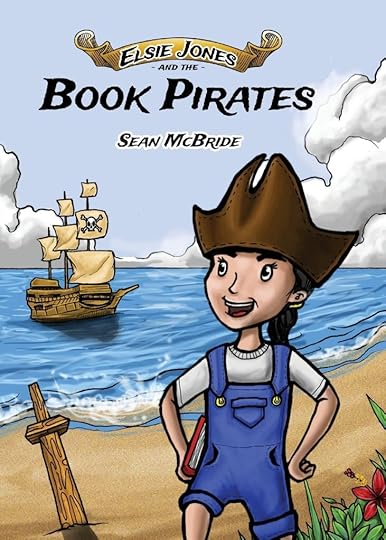
This is my children’s chapter book series which features Elsie, a head strong young girl who finds a mysterious room in her local library that has some interesting books hidden within. Books that pull her into them and make her go on the adventures of their stories! The only catch is that there is a nefarious man with an army of agents who have found their way into the books as well. Featuring classics such as Treasure Island, Dracula, The Casebook of Sherlock Holmes, and the Three Musketeers (maybe even some Tolkien inspired tales), Elsie must find a way to protect literature from the nefarious Dark Hats.
The first three books are available on this website and wherever books are sold, but the Author editions will be coming out starting next spring followed by the remaining 12 books every few months!
The Legacy:
I grew up in the era of Indiana Jones and The Goonies. These action packed adventures have always fueled my imagination, then in college I read a Rolling Stone article about a mysterious Island off the coast of Nova Scotia called Oak Island. They have since made a History Channel show about the treasure hunt on the island, but I wanted to make my very own Indiana Jones type story which could follow around a group of adventurers through multiple books. The Legacy is their attempt to solve the mystery of Oak Island. I’m now in the third draft and getting very close to submissions. Expect this book early 2024.
The Revolution Cycle:
This is my Magnum Opus. This will be a fantasy adventure told over ten books. It will cover a Revolution from it’s start to finish, beginning with the first book “A Monster in the Woods.” The first book will be a heist/fantasy plot line surrounding a group of teenagers who find some information that will change the world, all while trying to stay safe and away from a creature whom seems to be stalking them, and a despotic Duke trying to catch them. Featuring court dances, politics, and romance, but relying heavily on adventure and a smattering of horror, anyone who loved the nostalgia of the 80’s adventures as much as I do will love it.
The outline is complete and once Elsie Jones is in a rythym of publishing, this will get more attention.
As always thank you for coming here and reading my blog! If there is any kind of short story you’d like to see over the next fourteen weeks, I have 3 slots available and I’d love to write one surrounding your favorite horror/mystery!
September 28, 2022
What Writers Don’t Know
What writers don’t know is that boring books of the dead will make their readers die. Mummies come alive when their hearts are stolen and their skin is up-tight. I look at my brain pickled in a jar and it’s not kosher. We are so quick to take offense at the smallest slight. Our skin […]
What Writers Don’t Know
Top 10 Toho Monsters We Want in the Monsterverse
In light of recent announcements that the Monsterverse will continue to stomp forward with a Godzilla Vs Kong sequel as well as an animated and Live action series set in the universe, we take a look at some of Godzilla’s most famous friends/foes who have yet to make an appearance in the colossal franchise. News […]
Top 10 Toho Monsters We Want in the Monsterverse
September 22, 2022
Blind Viewing: J.R.R. Tolkien; The Rings of Power, Episode 1

“We had no word for death, for we thought our joys would be unending. We thought our light would never dim. So when the great foe Morgoth, destroyed the very light of our home we resisted. An a legion of Eleves went to war. We left Valinor, our home, and journeyed to a distant realm. One filled with untold perils, and strange creatures beyond count. A place known as Middle-earth.”
Welcome back to another Blind Read! Or, in this case, let’s call it a blind watch! This week, we’re taking a step back from The Silmarillion and reviewing the first episode of “The Rings of Power” on Amazon.
The show is pretty much what I was expecting. It corrupts the lore of Tolkien, using some, changing most, and making much up on their own.

That may sound like a denigration of the show, but it is entertaining – Of which you can’t deny when you first look at Valinor and its two shining trees. People who have not read the Silmarillion will probably take great joy in the show because they get to return to Middle-earth and join along with a few characters they remember from the Movies. Namely Galadriel and Elrond.
So there is entertainment value in the show, and the special effects and visuals of the first episode are incredible. If nothing else, you can tell this was a labor of love for at least the special effects crew.
I have not finished the book (nor any of the other histories which expound upon the core that is The Silmarillion, but if you’ve been reading along with me, you know that), but just getting through the Quenta Silmarillion has given me a good enough knowledge to notice the inconsistencies in the show.
The first of which is in this introduction. We start by viewing Galadriel and Finrod Felagund speaking in Valinor, but the show ignores the entire Fëanor and Silmril plot, which was the fundamental basis of The Silmarillion. In the book the storyline was an effort to show a fall from grace and how people born with the best intentions were corrupted by greed, hubris, and familial bond. If you remember, Fëanor created the Silmarils, and Morgoth stole them with the help of the great and horrible Ungoliant, Shelob’s mother.

Morgoth was a Valar, a creation of Ilùvatar, the God of Arda (“God,” for lack of a better term). Ilùvatar created the Valar, who in turn created the world they created through their song from Valinor. Morgoth was a fallen angel who was jealous of the abilities of the Children of Ilùvatar (The Eldar, or Elves). So he stole the Silmaril’s, which held the light of Valinor, and went to Middle-earth. That is all true.
What the show doesn’t cover is that Fëanor and his sons and the rest of the Noldor (Galadriel included), Killed their kin because they were denied an exit from Valinor, and then they stole boats and sailed to find Morgoth and take the Silmarils back.
The showrunners did this because they wanted to keep the Elves the uncomplicated heroes of the show. They needed them to be beings that the viewers would root for, yet that depth of character, which they tried to infuse within Galadriel, is lost on the rest of the Elves.
So we see in the opening quote of this essay, which is part of the opening voiceover from Galadriel, that the Elves chased Morgoth to Middle-earth to battle the called angel. They include every grand battle and say that the war lasted for centuries, but they gloss over the other incredible stories of the age. But, of course, they didn’t have the rights to those stories, so we can’t blame them for it, and there is a possibility that they framed the show this way because they were not allowed to mention the I.P. of The Silmarillion, I.E., the Silmarils.
So all of that is just the setup for the show. The introduction has some spectacular visuals, and it was fascinating to see the aftermath of the Fifth Battle called Nirnaeth Arnoediad. For example, the pile of Elven helms (which probably should have been bodies, but it’s a show), which was called Haudh-en-Nirnaeth, or the Hill of Tears (The fifth battle was called Unnumbered Tears), which eventually grew over with grass. You’ll notice this heartbreaking scene immediately when you watch it.
The first considerable divergence the show takes, however, is that Galadriel’s Brother, Finrod Felagund. In the show he falls in battle with Sauron, which is factually incorrect. Instead, he falls in battle with Morgoth, so the back story of Galadriel in the show is false.
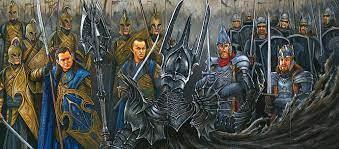
The second divergence is The High King Gil-Galad sends the warriors of the Elves back to Valinor, presumably to get them out of the way because Gil-Galad doesn’t believe that Sauron will come back in the next few centuries, if ever. The problem is that at this time, sending the elves to Valinor is not a decision that Gil-Galad can make. It has to be approved by the Valar, and if he had that palaver, there is no way the Valar would allow all of the warriors to return. Not to mention that Galadriel is the last of the Noldor who are accountable to the Curse of Mandos, so she would never be allowed to return to the undying lands.
The scene of the warriors entering Valinor is breathtaking, however, showing the showrunners’ love for the source material. I just wish they had not changed the motivation and basis of Galadriel herself.
I did enjoy the episode, however there are more things to say. First, there is quite a bit of back and forth about black elves. I have seen articles and posts on Social Media where people thought there were no black elves in Middle-earth. I’m here to say that if you hold this belief and you think all elves are described as golden haired, white, and thin, then you did not read the Silmarillion. The description of the Moriquendi, otherwise known as dark elves, had dark (sometimes grayish) skin and dark hair; not to mention the most famous of the Dark Elves, Eöl, the master of the forge and father of Maeglin.
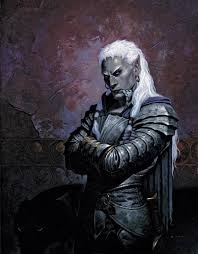
The second is a specific point of interest. It is said in The Silmarillion that because Galadriel is the last of the Noldor who had seen Valinor’s light (yes, despite the actress’s age, she is the oldest of all the Elves in Middle-earth during the events of the show), the light of the trees are reflected in her eyes. The show does a great job at having that reflection of the light of the trees of Valinor in her eyes at all times.
I hope you all enjoy the show as well! Next week we’re returning to the book with The Akallabêth, which is (I think) the history of the Nùmenorians and the second age!
We have a lot to talk about, so join me every Thursday!
September 15, 2022
Blind Read Through: J.R.R. Tolkien; The Silmarillion, Of the Voyage of Eärendil and the War of Wrath
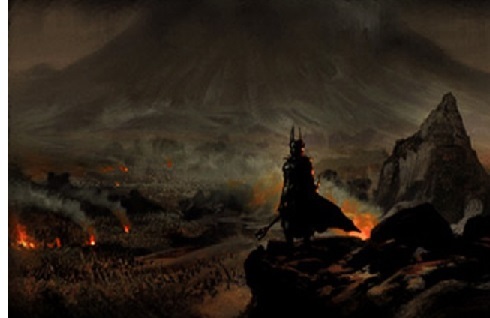
“The meeting of the hosts of the West and the North is named the Great Battle, and the War of Wrath. There was marshalled the whole power of the Throne of Morgoth, and it had become great beyond count, so that Anfauglith could not contain it; and the North was aflame with war.”
Welcome back to another Blind Read! This week we review The War of Wrath and the end of the Quenta Silmarillion.
Last week we learned of Eärendil and Elwing and their plea to the Valar to come and help the people of Beleriand. Through those two half-elves’ sacrifices, they gained Valinor’s assistance against Morgoth. “Yet it is said that Morgoth looked not for the assault that came upon him from the West; for so great was his pride become that he deemed that none would ever again come with open war against him.”

Yet come they did. The Valar came along with the Noldor, who never left Valinor and the Vanyar. Even a host of Teleri marched to battle despite their kin’s memory of the slaying at Swanhaven (Fëanor and his followers) because they “hearkened to Elwing.” Which leads directly into the opening quote of this essay.
The power of Morgoth’s armies was immense, but it could not stand up to the Valar. “The Balrogs were destroyed, save some few that fled and hid themselves in caverns inaccessible at the roots of the earth; and uncounted legions of the Orcs perished like straw in a great fire.”
Morgoth made one last ditch effort and sent out the horror of the fleet of dragons from the pits of Angband. “And so sudden and ruinous was the onset of that dreadful fleet that the host of the Valar was driven back, for the coming of the dragons was with great thunder, and lightning, and a tempest of fire.“
The power of the dragons was immense, but the King of the Eagles, Thorondor, came with his host along with Eärendil upon the flying Vingilot. They met the dragons in the sky and turned the tide. Eärendil even killed Ancalagon the Black, “the mightiest of the dragon-host,” who was so large that he could crush mountaintops under his claws. When Ancalagon fell from the sky, “he fell upon the towers of Thangorodrim, and they were broken in his ruin.“
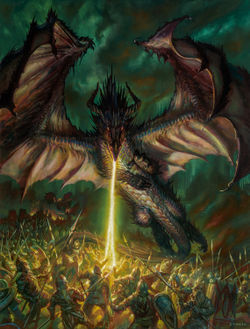
Finally, the host of Valar was victorious. They descended into earth to gather Morgoth, but the dark king “fled into the deepest of his mines and sued for peace and pardon; but his feet were hewen from under him, and he was hurled upon his face. Then he was bound with the chain Angainor which he haed worn aforetime, and his iron crown they beat into a collar for his neck, and his head was bowed upon his knees. And the two Silmarils which remained to Morgoth were taken from his crown, and they shone unsullied beneath the sky; and Eönwë took them, and guarded them.“
The battle was so devastating that it ended the epoch. The world was physically changed from the drama of the fight. “and the sea roared in through many chasms, and there was confusion and great noise; and the rivers perished or found new paths, and the valleys were upheaved and the hills trod down; and Sirion was no more.“
Many landmarks are the same throughout the ages of Middle-earth (for example, Gondolin is undoubtedly Minas Tirith); however, the landscape is entirely different in the first age from what I know of the Third Age. This battle, “The War of Wrath,” was so devastating that the actual earth was rent and made new. There is a minimal description of the fight in the book; in fact, most of Tolkien’s descriptions are in this essay, but this devastation shows the outright power of the Valar. The book is long and challenging to read, so while reading through the mythos of the Elves as they came to Beleriand, I somewhat forgot that the Valar created the world with their music. A being who can make a world would have the power to destroy or remake that same world. The remaking of Beleriand was either a happy accident or the intent of the War of Wrath because the Valar wanted to eliminate the memory and the scar of Morgoth from the world.

Thus ended the Silmarillion and the reign of Morgoth, but it would not be Tolkien if we didn’t have a little “there and back again.”
The surviving sons of Fëanor, Maedhros and Maglor, still had not held up their oath to their father. So after Eönwë called Elves back to Valinor in the West, they still schemed and wondered if it were worth a battle with the Valar to take the Silmarils back, knowing it would cost them their lives.
They decided to send a message to Eönwë and ask for the two remaining Silmarils, “But Eönwë answered that the right to the work of their father, which the sons of Fëanor formerly possessed, had now perished, because of their many merciless deeds, being blinded by thier oath, and most of all because of their slaying of Dior and the assualt upon the Havens.”
Maedhros and Maglor took council with each other, with Maglor wanting to submit and break their oath because “‘whether we keep our oath or break it; but less evil shall we do in breaking.” But Maedhros knowing the evil they had already committed, talked Maglor into trying to fulfill their oath.
The two Noldor broke into the camp of Eönwë, killed the guards, and took the Silmarils. But an alarm was raised, and the camp came against them. They were immediately caught, “but Eönwë would not permit the slaying of the sons of Fëanor,” and he allowed them to take the Silmarils. He could see the future because the Silmarils caused the remaining sons of Fëanor great pain. So much pain, Maedhros threw himself into a great chasm with the Silmaril so that it was “taken into the bosom of the Earth.“
Maglor threw the Silmaril into the sea because he could not bear the pain, but the pain did not abate once the Silmaril was gone because it was the knowledge of all the wrongs he perpetrated made manifest. So Maglor spent the rest of his days “singing in pain and regret by the waves.”
Most of the Eldalië went back west into the undying lands, but a few stayed, building upon the future of Middle-earth.
“Among those were Círdan the Shipwright, and Celeborn of Doriath, with Galadriel his wife, who alone remained of those who led the Noldor to exile in Beleriand. In Middle-earth dwelt also Gil-galad the High King, and with him was Elrond Half-elven, who chose, as was granted him, to be numbered among the Eldar; but Elros his brother chose to abide with Men. And from these bretheren alone has come among Men the blood of the Firstborn and a strain of the spirits divine that were before Arda; for they were the sons of Elwing, Dior’s daughter, Lúthien’s son, child of Thingol and Melian; and Eärendil their father was the son of Idril Celebrindal, Turgon’s daughter of Gondolin.“
I believe this is the foundation of the Nùmenorians from Elros’ line, and we all know what becomes of Elrond’s line. Not to mention Galadriel, prominently featured in the new Rings of Power Amazon original.
Thus the Silmarillion or the great long struggle of the First Age ends. Morgoth was “thrust through the Door of Night beyond the Walls of the World, into the Timeless Void.” And he is never to return.
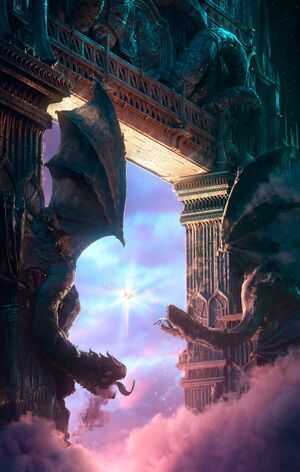
Tolkien ties up all the loose knots but one, which I believe he did on purpose because it is the draw to bring the reader back to the next portion of the book: Akallabêth and Of the Rings of Power and the Third Age. The loose knot? What happened to Sauron? He was not mentioned during the War of Wrath, and one can only imagine he is hidden away in Taur-Nu-Fuin, which becomes Mordor in later Ages.
There is a very satisfying conclusion to the tale, and I can’t wait to get into Akallabêth because I believe it describes the events of the Second Age and what The Rings of Power show is partially based on.
Let’s find out next week as we start our journey with Akallabêth!
September 8, 2022
Blind Read Through: J.R.R. Tolkien; The Silmarillion, Of the Voyage of Eärendil and the War of Wrath, Part 1

“And the wise have said that it was by reason of the power of that holy jewel that they came in time to waters that no vessels save those of the Teleri had known; and they came to the Enchanted Isles and escaped their enchantment; and they came into the Shadowy Seas and passed thier shadows, and they looked upon Tol Eressëa the Lonely Isle, but tarried not; and at the last they cast anchor in the Bay of Eldamar, and the Teleri saw the coming of that ship out of the East and they were amazed, gazing from afar upon the light of the Silmaril, and it was very great.”
Welcome back to another Blind Read! This week we start the process of closing the Quenta Silmarillion as we review the fates and legacy of the two half-Elves looking to save the world from not only Morgoth but their own kind.

We pick up right where we left off in the last chapter, with Eärendil marrying Elwing and having two boys, Elros and Elrond. Yes, that Elrond. Eärendil was restless because of how he viewed the progression of the destruction of Beleriand, so he took to the sea. “Seeking after Tuor and Idril who returned not; and he thought to find perhaps the last shore, and bring ere he died the message of Elves and Men to the Valar in the West, that should move their hearts to pity for the sorrows of Middle-earth.“
Eärendil became friends with Círdan the Shipwright, who built him a fantastic ship named Vingilot, the Foam-flower. He left his family on the coast and sailed West to find answers, but something nagged at him. It was the fear of the remaining sons of Fëanor and what they would do to fulfill their oath. He was right to fear because when the tidings came to Maedros that Elwing lived and had the Silmaril, he gathered his brothers and they demanded the Silmaril, but Elwing refused to relinquish it. “And so there came to pass the last and cruelest of the slayings of Elf by Elf; and that was the third of the great wrongs achieved by the accursed oath.“
The Noldor won the day, but only Maedros and Maglor survived the battle. Elrond and Elros were taken captive, but Elwing, wearing Nauglamír, complete with the Silmaril, cast herself into the sea.

Ulmo came to her rescue and turned her into a “great white bird,” yet again calling reference to the swan boat referenced at the beginning of this book and Galadriel’s ship in The Lord of the Rings.
Elwing, as a bird, found Vingilot and landed on the ship, only then turning back into Elwing. She relayed the events of the last great slaying to her husband, and they feared the loss of their sons, so they did the only thing they could think of doing. They sailed for Valinor to try and gain assistance from the Valar. We get the opening quote of this essay here.
Elwing and Eärendil step to the shores of Valinor but ask the other sailers to stay on the boat because they think that by stepping back on the shored of the Valar, they will not return alive. Their only hope is to get the Valar to agree to help those still living under Morgoth’s wrath.
They come before the council of the Valar, where an excellent discussion about what to do with them takes place. Mandos, the Valar who proclaimed the great curse which eventually led to the Noldor’s destruction, volleyed to have them put to death, for they came to the undying lands unbidden. However, cooler heads prevailed, and Manwë forgave them, if only because they came to Valinor to save others. He gave them a choice, however; “to Eärendil and to Elwing, and to their sons, shall be given leave each to choose freely to which kindred their fates shall be joined, and under which kindred they shall be judged.“
Both Eärendil and Elwing chose to be judged “among the Firstborn Children of Ilùvatar,” thus adhering, at least in part, to the Curse of Mandos.
The Valar sent a significant wind which set the sailors on the boat back to Beleriand, “but they took Vingiot, and hallowed it, and bore it away through Valinor to the uttermost rim of the world; and there is passed through the Door of Night and was lifted even into the oceans of heaven.“
And that is the fate of Eärendil. He is to sail the stars for the remainder of eternity with the Silmaril on his brow, shining brighter than any star. In fact, “when this new star was seen at evening, Maedros spoke to Maglor, his brother, and he said: ‘surely that is a Silmaril that shines now in the West?’
“And Maglor answered: ‘If it be truly the Silmaril which was cast into the sea that rises again by the power of the Valar, then let us be glad; for it’s glory is seen now by many, and is yet secure from all evil.'”
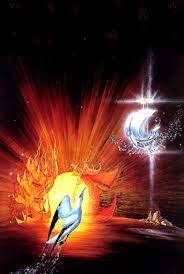
This end brought the light of the Trees of Valinor to the world, without ever having a single being be in charge of keeping the Silmaril, and thus lightened a load of all living beings to just existing. The Power the Silmarils held was never meant to be in the lands beyond Valinor because the gems indicated that a mortal (or semi-mortal) being could be close to godliness. The Light of the Trees was a creation of the music of the Ainur, spurned on by Ilùvatar himself (itself?). Fëanor created them not out of reverence for his betters but out of a lust to be more like them. That is what the power of the Silmarils entails, and that is why no one can seem to give them up when they have one (with the significant exception of Lùthien). They are a piece of God-made tactile. People still fight over lands they deem holy because they believe God was born there. Can you imagine what they would do if they knew there was a physical talisman which embodied God in the world? This is what caused the strife of Beleriand. This is what caused the world’s wars. Because one Noldor deemed that it was his birthright to be more like a god, he ascended high enough to create an aspect of that light but not high enough to become part of it.
Meanwhile, Elwing stayed on Valinor in a large white tower built by the Valar. “And it is said that Elwing learned the tongues of birds, who herself had once worn their shape; and they taught her the craft of flight, and her wings were of white and silver-grey.“
In Tolkien, there is always a node of hope in the harshest stories. For example, Elwing and Eärendil sacrificed themselves to end the strife of Beleriand. They were ostracized and put to death, owning the curse of Mandos to end it. But hope comes because whenever Eärendil comes close to Beleriand, Elwing becomes a bird and flies to meet him and be with her husband again. This is somewhat reminiscent to another resurrection story where someone takes on the sins of others…
The scene of them riding through the sky, however, is reminiscent of many old Mythologies and adds to the magic and wonder of the world. More importantly, it shows that though they took the curse on their shoulders, they still can be together, fly over the world of Middle-earth, and view their children growing up and old while being close to the light of their God.
We are nearly there; just a few pages more! Join me next week as we conclude The Quenta Silmarillion!
September 1, 2022
Blind Read Through: J.R.R. Tolkien; The Silmarillion, Of Tuor and the Fall of Gondolin
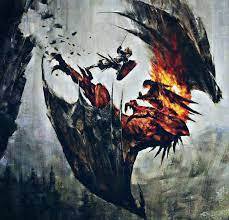
“Therefore in that time the very entrance to the hidden door in the Encircling Mountains was caused to be blocked up; and thereafter none went ever forth from Gondolin on any errand of peace or war, while that city stood. Tidings were brought by Thorondor Lord of Eagles of the fall of Nargothrond, and after of the slaying of Thingol and of Dior his heir, and the ruin of Doriath; but Turgon sht his ear to word of the woes without, and vowed to march never at the side of any son of Fëanor, and his people he forbade ever to pass the leaguer of the hills.”
Welcome back to another Blind Read! This week we witness the fall of the Elves’ last great city and Beleriand’s continued destruction.
Tolkien starts by reminding us of Tuor, Túrin’s cousin, who was captured at a young age by Easterlings and Orcs and kept in captivity for three years. Once he escaped, he spent the next four years living in solitude and “did such hurt to the Easterlings” that they set a bounty on his head.
Ulmo, the only Valar that seemed to care for the Children of Ilúvatar, “had chosen Tuor as the instrument of his designs” and saved Tuor by bringing him through a tunnel filled with raging water to Nevrast by the sea.

Tuor stayed there for some time until he finally found “the deserted halls of Vinyamar beneath Mount Taras, and he entered in, and found there the shield and hauberk, and sword and helm, that Turgon had left there by the command of Ulmo long before.”
There are many callbacks to previous chapters, but they raise more questions than answers. For example, did Ulmo foresee this destruction coming to Beleriand when the Noldor left Valinor? Is that why he instructed Turgon to leave equipment there? Because he knew there would eventually be someone to come and take it to make some stand? And an even bigger question, Ulmo is the protector of the Children of Ilúvatar, but does this foreknowledge make him complicit in the destruction? Or was there no other way around it?
In any case, in Vinyamar, Tuor came across Voronwë, the son of Aranwë, one of the Elves that Turgon sent to sea. Voronwë, understanding that Tuor was on a mission from Ulmo, assisted him in getting to Gondolin. Along the way, they passed a tall man, “clad in black, and bearing a black sword…” which is Tolkien’s way of setting the timeline for us because this is very obviously Túrin heading back to Hithlum.
Tuor finally makes it to Gondolin and is led before King Turgon “and all that heard the voice of Tuor marvelled, doubting that this were in truth a Man of mortal race, for his words were the words of the Lord of the Waters.“
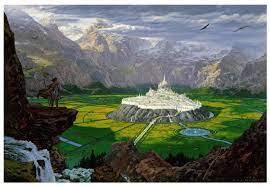
Tuor “gave warning to Turgon that the Curse of Mandos now hastened to its fulfillment, when all the works of the Noldor should perish; and he bade him depart, and abandon the fair and mighty city that he had built, and go down Sirion to the sea.”
Again here we have information of foreknowledge by the Valar. This First Age seems more and more like a punishment for leaving Valinor in the first place. It almost feels like the Valar wanted the Eldar with them in Valinor, leaving the world of Beleriand for Men and Dwarves.
There is even a passage where Turgon thinks back on something Ulmo said to him when he was getting to Beleriand, “Love not too well the work of thy hands and the devices of thy heart; and remember that the true hope of the Noldor lieth in the West, and cometh from the sea.”
Not only does Ulmo tell him that they will only be there for a little while and they truly belong to the West, but he then tells Turgon how to live so that he can return to finish his existence. Turgon, being Noldor through and through, “was become proud” and ignored those words. Even Maeglin, his nephew, believed in Gondolin and continued to hide, which leads directly to the quote which opened this essay.
So they stayed, and Tuor stayed with them. In time Tuor fell in love with Idril, daughter to Turgon, and they eventually married “and thus there casme to pass the second union of Elves and Men.” But Maeglin loved his cousin and held Tuor in great animosity. He took Idril from Maeglin, but not only that; he was an outsider and a Man to boot!

The following spring Eärendil was born of Tuor and Idril, and Maeglin’s resentment grew. We have already seen in the chapter about Maeglin that he strove to make unique and powerful weapons and armor, but we see here that he ranged deep into the mountains and far from home, trying to get materials for these forgings.
We also know that Húrin cried out to the mountains that hid Gondolin, hoping for help from Turgon, and Morgoth’s agents watched so they knew the general region of Gondolin. So when Maeglin searched for materials, Morgoth’s agents caught him and brought him to Angband.
He was tortured there and made a deal with Morgoth. His torment, hope for the future, and resentment led him to this betrayal, far more than any of the torture Morgoth put him through. The deal was that Maeglin would reign underneath Morgoth’s rule in Gondolin and take Idril’s hand in the process.
It took years for Morgoth to make his move, but in the Summer when Eärendil was seven, Morgoth released his fury upon Gondolin.
“Of the deeds of desperate valour there done, by the cheiftans of the noble houses and their warriors, and not least by Tuor, much is told in The Fall of Gondolin: of the battle of Ecthelion of the Fountain with Gothmog Lord of Balrogs in the very sqaure of the King, where each slew the other, and the defence of the tower of Turgon by the people of his household, until the tower was overthrown; and mighty was its fall and the fall of Turgon in its ruin.“

Tuor and Idril escaped with their son, but Maeglin caught them. Tuor and Maeglin had a mighty battle, but eventually, Tuor “cast him far out, and his body as it fell smote the rocky slopes of Amon Gwareth thrice ere it pitched into the flames below.” Thus Maeglin ended.
But Tuor and his family’s exit was not complete. They escaped through the mountains, but a group of Orcs and a Balrog found them. Glorfindel saved them while riding the King of the Eagles, Thorondor. They had a mighty battle, and eventually, Glorfindel and the Balrog fell from the mountain and perished.
Finally, their escape was complete, and they fled south with Ulmo’s aid down the Sirion to the sea, where they met up with Elwing, who held Nauglamír and the Silmaril.
Morgoth felt his sack of Beleriand was complete, “recking little of the sons of Fëanor, and of their oath, which had harmed him never and turned always to his mightiest aid; and in his black thought he laughed, regretting not the one Silmaril that he had lost, for by it as he deemed the last shred of the people of the Eldar should vanish from Middle-earth and trouble it no more.”
Meanwhile, Ulmo called for forgiveness of the sons of Fëanor and to rescue them from Morgoth’s wrath, but Manwë was unmoved by Ulmo’s cries; “and the oath of Fëanor perhaps even Manwë could not loose until it found its end, and the sons of Fëanor reliquished the Silmarils, upon which they had laid their ruthless claim. For the light which lit the Silmarils the Valar themselves had made.”
What I find so interesting about this is that the Noldor don’t have the Silmarils anymore, but Morgoth does. So the Valar are blinded by their Hubris and can’t see past the fact that the Silmarils were taken in the first place, despite Fëanor making them.
There is one Silmaril left that Morgoth does not possess, and it’s in the hands of a young Elf who just met a young half-elf. Eärendil and Elwing, heirs of the great Kings of Middle-earth. Do they sail to Valinor and hand the Silmaril back to Manwë? Is that what brings the change and leads the Valar to battle against Morgoth?
There’s only one chapter left, so let’s find out next week in “Of the Voyage of Eärendil and the War of Wrath!”
August 25, 2022
Blind Read Through: J.R.R. Tolkien; The Silmarillion, Of the Ruin of Doriath, Part 2
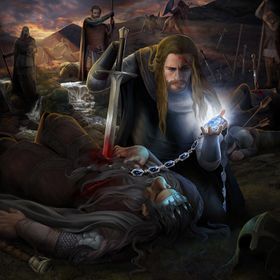
“Thus it came to pass that when the Dwarves of Nogrod, returning from Menegroth with diminished host, came again to Sarn Athrad, they were assailed by unseen enemies; for as they climbed up Gelion’s banks burdened with the spoils of Doriath, suddenly all the woods were filled with the sound of elven-horns, and shafts sped upon them from every side. There very many of the Dwarves were slain in the first onset; but some escaping from the ambush held together, and feld eastwards towards the mountains. And as they climbed the long slopes beneath Mount Dolmed there came forth the Shephers of the Trees, and they drove the Dwarves into the shadowy woods of Ered Lindon: whence, it is said, came never one to climb the high passes that led to their homes.”
Welcome back to another Blind Read! This week we come back to the tragic conclusion of the Ruin of Doriath and understand how the races came to hate each other.
Last week we left off with the murder of King Thingol in his very chambers. The power of the Silmaril, which the Dwarves forged into Nauglamir, was too great and created envy that overrode their memory and senses. They were suddenly angry because they felt Thingol didn’t deserve Nauglamír, as it was a gift to Finrod made by the Dwarves. So when Thingol asked them to reforge it with the Silmaril, they did so without hesitation. Still, after giving it back, the absence of the light of Valinor made them regret their decision, so they struck Thingol down, took Nauglamír, and fled Menegroth.
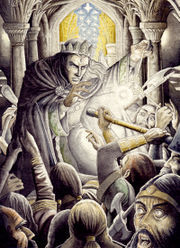
But they were “pursued to the death as they sought the eastward road, and the Nauglamír was retaken, and brought back in bitter grief to Melian the Queen.” Her thoughts grew dark, “and she knew that her parting from Thingol was the forerunner of a great parting and that the doom of Doriath was drawing neigh.”
In her grief, her magic waned, and the Girdle protecting Doriath fell, “and Doriath lay open to its enemies.” So she gave Nauglamír, inlaid with the Silmaril, to Mablung and asked him to send word to Beren and Lúthien, then “she vanished out of Middle-earth, and passed to the land of the Valar beyond the western sea, to muse upon her sorrows in the gardens of Lórien, whence she came.“
Two dwarves escaped the attack on the murderers of Thingol, however, and went back to their kin in Nogrod. These Dwarves vowed vengeance and gathered a great host to march on Doriath, “and there befell a thing most grievous among the sorrowful deeds of the Elder Days.”
The Dwarves lost many of their kin in the battle in Menegroth, but they sacked the city; “ransacked and plundered.” Finally, they killed Mablung and took back Nauglamír and the Silmaril.

Word spread quickly of the terrible act the Dwarves perpetrated, and soon Beren and Lúthien heard of it. So Beren gathered his son Dior and a host of Green Wood Elves and went after the Dwarves; their confrontation is the opening passage of this essay.
They slaughtered the Dwarves, Beren himself killing the King of Nogrod. Then, finally, the Elves and Beren drowned the treasure of Menegroth in the river Ascar, all that is, but Nauglamír and the Silmaril.
Now the Silmaril was back in his hands, the item he fought so hard to win Lúthien’s hand in marriage by cutting it out of Morgoth’s crown. He took it to Lúthien, and she wore it for protection, and “it is said and sung that Lúthien wearing that necklace and that immortal jewel was the vision of greatest beauty and glory that has ever been outside realm of Valinor.”
Dior, Thingol’s heir, took it upon himself to bring the glory of Doriath back. So he brought his wife Nimloth, his boys Eluréd and Elurín, and his daughter Elwing to Menegroth, and there he became the new King of Doriath and raised a new kingdom there.
There, in Menegroth, Dior brought greatness back until one day a group of Green Elves came calling. They brought with them Nauglamír and the Silmaril. Proof that Beren and Lúthien, his parents, had passed from the world of Men and Elves. “But the wise have said that the Silmaril hastened their end, for the flame of the beauty of Lúthien as she wore it was too bright for mortal hands.“
Dior knew this, but the call of the Silmaril was too strong, so he began to wear it, and in doing so, the Silmaril called for another end of Doriath.
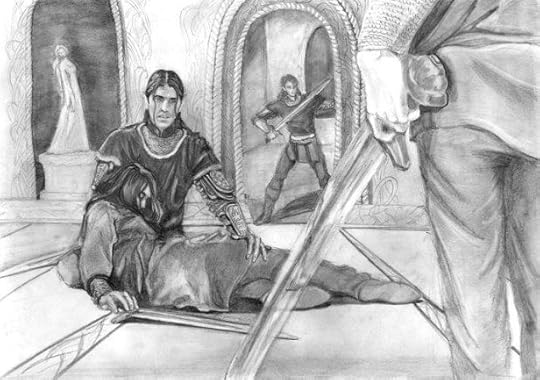
The Sons of Fëanor laid a new claim to the Silmaril and demanded that Dior relinquish the jewel. When he refused, “Celegorm stirred up his brothers to prepare an assault on Doriath.”
They fought a battle that all would remember. Celegorm, Curufin, and dark Caranthir all died by Dior’s hand, but they, in turn, killed the new king of Doriath and Dior’s wife, Nimloth. The “cruel servants of Celegorm” also took Dior’s boys Eluréd and Elurín and set them to be lost and starve in the woods. The only survivor of the household was Elwing, who was given Nauglamír, and fled to the sea at the mouth of the River Sirion.
“Thus Doriath was destroyed, and never rose again.”
The sons of Fëanor sought, all the way back when they were still in Valinor, to gain the three gems known as the Silmarils their father made. The light of the trees of Valinor infused within them gave a longing call to the life they once had lived. So they spent more time on Beleriand than they did in Valinor, pining for the gems which reminded them of the world they left behind.
The Murder of the King of Nogrod also had a lasting effect on the Dwarves, and because of their stubbornness was something their race never forgot, even though the whole war was pretty much their fault in the first place. Beyond that, the Elves have proven time and time again that they can’t trust anyone, not even their own kin.
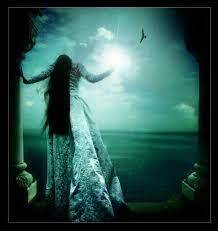
I find it fascinating that the whole world was turned upside down because of these artifacts that were only sought because of their beauty. They were created to be an homage to the light of Valinor, and they became the destruction of Beleriand. The strange part about that is that they don’t hold any specific power; it’s just that they are beautiful, which shows the ignorant and selfish nature of the Elves. They are called the Children of Ilùvatar, and that is precisely how they act, like petulant children who can’t share.
Only two chapters are left, and one has to wonder where the Valar are. Will Melian inform them about how bad the infighting had gotten? How will Morgoth be handled? Where will Elwing and the Silmaril end up next?
Let’s find out next week as we dive into “Of Tuor and the Fall of Gondolin.”
August 18, 2022
Blind Read Through: J.R.R. Tolkien; The Silmarillion, Of The Ruin of Doriath, Part 1

“It is told that a seer and harp-player of Brethil named Glirhuin made a song, saying that the Stone of the Hapless should not be defiled by Morgoth nor ever thrown down, not though the sea should drown all the land; as after indeed befell, and still Tol Morwen stands alone in the water beyond the new coasts that were made in the days of the wrath fo the Valar. But Húrin does not lie there, for his doom drove him on, and the Shadow still followed him.“
Welcome back to another Blind Read! This week Húrin, Túrin’s father, returns to the story as the second of the great kingdoms of the First Age topple.
Tolkien introduces us to this chapter by letting us know that Morgoth had been watching the events closely in Doriath and “In all ways Morgoth sought most to cast an evil light on those things that Thingol and Melian had done, for he hated them, and feared them.“
After twenty-eight years, Morgoth released Húrin from his captivity in Angband, “and he feigned that in this he was moved by pity as for an enemy utterly defeated.“

But Húrin was a marked man. He had been in captivity for so long that no one believed that he wasn’t a thrall of Morgoth. So he went to his people in Hithlum, but they shunned him in fear that he might lead an army to their front door because why would Morgoth suddenly release him after twenty-eight years if not to use him?
They were right to be scared because the agents of Morgoth watched his every move from a distance unbeknownst to Húrin.
Turned away from his people, Húrin turned to Gondolin, but the same fate held him there. Gondolin stayed hidden from him against Throndor, the great eagle’s wishes. Turgon decided too late to trust Húrin, and he never saw the human again. Still, his curse stuck with the Elf because, under the view of Morgoth’s spies, Húrin cried out to the mountains where the hidden entrance was to let him in, “and now Morgoth smiled, for he knew now clearly in what region Turgon dwelt.” We are told a few sentences later, “This was the first evil that the freedom of Húrin achieved.“
The despair of Húrin deepens and he stumbles around until he finally comes upon a large stone, “But Húrin did not look at the stone, for he knew what was written there.” Namely the memorial for his children. Sitting at the stone, he finds Morwen, spent and ready to pass away. She doesn’t seem surprised to see him, almost as if he were a shade coming to her in the twilight. They speak for a moment and watch the sunset together, holding hands as she passes away.
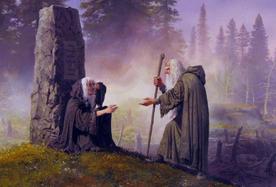 “Passing of Morwen” by Ted Nasmith
“Passing of Morwen” by Ted NasmithHe builds a monument for her, and this monument is the opening quote of this chapter.
Húrin’s loss and desperation is where the story of Doriath’s fall begins. Húrin travels the land and eventually comes across the ruin of Nargothrond, the house of Finrod Felagund, where Glaurung the dragon made a home and gathered all the treasures of the Elves together. An old character reemerges as we find him sitting on the stores of Gold. It is Mîm, the petty dwarf who betrayed Túrin.
They exchange words, and Húrin slays him. “Then he entered in, and stayed a while in that dreadful place, where the treasures of Valinor lay strewn upon the floors in darkness and decay; but it is told that when Húrin came forth from that wreck of Nargothrond and stood again beneath the sky, he bore with him out of all that great hoard but one thing only.” Nauglamír, the Necklace of the Dwarves, made for Felagund by Nogrod and Belegost, is one of Finrod’s most prized possessions.
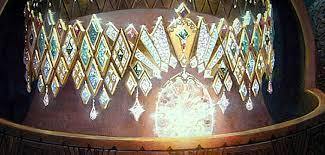
Taking the prize, Húrin traveled to Doriath, eventually stood before Thingol, and threw Naulamîr at the King’s feet. He disparaged Thingol for not protecting his family, and by throwing the necklace at his feet, he intimated that Felagund was willing to go and fight, whereas Thingol thought he was too important; thus, Thingol was a coward and a breaker of promises.
Thingol accepted the jibes, but Queen Melian stood and spoke to Húrin, telling him the truth of the matter, that they did everything they could for Húrin’s family, short of imprisoning them to restrain them. She finished, “With the voice of Morgoth thou dost now upbraid thy friends.“
Húrin realizes his mistake and understands that the only thing keeping him alive was his anger, so “it is said that Húrin would not live thereafter, being bereft of all purpose and desire, and cast himself at last into the western sea; and so ended the mightiest of the warriors of mortal Men.“
But the damage had been done. Nauglamír was now in Menegroth at Thingol’s feet. The power of the Silmarils burned in Thingol’s memory as he looked at Nauglamír, “and it came into his mind that it should be remade, and in it should be set the Silmaril.”
Thingol went to the Dwarves and asked them to reforge the necklace, which they did in earnest. But the power of Fëanor’s creation created corruption, much like the One Ring in the Third Age. The Dwarves wanted nothing more than to keep Nauglamír once they forged it; “By what right does the Elvenking lay claim to the Nauglamír that it was made by our fathers for Finrod Felagund who is dead?“
I’ve looked for it before, but this is the tipping point between Dwarves and Elves. They are mortal enemies when we see them in the Third Age (The Lord of the Ring and The Hobbit). So, where did that rift begin? So far in the First Age, they have pretty much worked together. The Dwarves of the Blue Mountains even forged Nauglamír for an Elven King and then did it again to add a Silmaril for Thingol.

So what caused the rift? The fire of Fëanor. The Silmarils hold the light of Valinor, and for these Elves, it is the last vestige of the beauty of that land for them. So few are still alive that even looked upon the light of the trees of Valinor before the Sun or the Moon, and the only three left in Beleriand are Thingol, Melian, and Morgoth.
The Simarils remind them of the innocence of youth. A time when there was no strife and the music of the Ainur filled the world. They recalled a time of beauty and creation.
So when the people of Beleriand looked upon it, they felt that love and innocence and fought for it, even if they didn’t realize why. And what happens when you desire something so much, and you have no idea why? What happens when someone else tries to take this thing you love?
“The then lust of the Dwarves was kindles to rage by the words of the King; and they rose up about him, and laid hands on him, and slew him as he stood. So died in the deep places of Menegroth Elwë Singollo, King of Doriath, who alone of all the Children of Ilùvatar was joined with one of the Ainur; and he who, alone of the Forsaken Elves, had seen the light of the Trees of Valinor, with his last sight gazed upon the Silmaril.“
Join me next week as we conclude “Of the Ruin of Doriath!”



